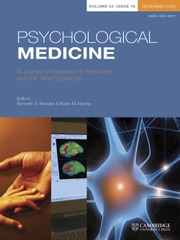Correspondence
Sir/Madam,
Impulsivity refers to behavior that is inappropriate, premature, or unduly hasty (Evenden, Reference Evenden1999); whereas compulsivity describes a tendency toward habitual, repetitive behavior, for which the link with the original goal has been lost (Gillan et al., Reference Gillan, Robbins, Sahakian, van den Heuvel and van Wingen2016). Originally conceptualized as being diametrically opposed, there is cross-talk between these two constructs: comorbidities are commonplace, hence there is a need for latent phenotyping approaches designed to capture differential contributions to both (Fontenelle et al., Reference Fontenelle, Oostermeijer, Harrison, Pantelis and Yucel2011; Hollander, Reference Hollander2014). Of genes likely to be relevant to understanding these concepts, the catechol-o-methyl transferase (COMT) Val158Met polymorphism (rs4680) is one likely contender. This genetic polymorphism regulates cortical dopamine degradation, with the Val-Val variant being associated with higher enzyme activity and thus with presumptive lower cortical dopamine levels (Tunbridge et al., Reference Tunbridge, Huber, Farrell, Stumpenhorst, Harrison and Walton2012).
The Val-Val variant of COMT has been linked to worse response inhibition (implicated in impulsivity) and worse set-shifting (implicated in compulsivity) (Mione et al., Reference Mione, Canterini, Brunamonti, Pani, Donno, Fiorenza and Ferraina2015; van Goozen et al., Reference van Goozen, Langley, Northover, Hubble, Rubia, Schepman, O'Donovan and Thapar2016). In a recent meta-analysis of the literature, the Val-Val form was significantly associated with attention-deficit hyperactivity disorder (ADHD) (p = 0.005; 99% confidence interval for odds ratio 0.858–0.994, with <1 indicating Val was over-represented) whereas the association with OCD was equivocal (p = 0.035, but 99% confidence for odds ratio 0.972–1.329) (Taylor, Reference Taylor2018). Part of the reason for inconsistent findings in the genetics literature may be a failure to control for the impact of impulsivity on compulsivity and vice versa.
In a recent paper published in Psychological Medicine (Chamberlain et al., Reference Chamberlain, Stochl, Redden and Grant2017), we identified separable latent phenotypes of impulsivity and compulsivity in a sample of 576 adults recruited from the general population. These dimensional phenotypes were constructed through latent factor analysis incorporating measures of symptoms, personality traits, and cognitive functioning. Across the study participants, latent scores were significantly associated with worse quality of life, highlighting their clinical relevance. Since publishing this paper we have obtained COMT polymorphism status from a random subset of the sample. The COMT polymorphism was in Hardy–Weinberg equilibrium (χ2 = 0.94, p > 0.05). As shown in Fig. 1, the Val-Val COMT variant was associated with significantly elevated latent phenotype compulsivity scores. No such differences were found for impulsivity scores (p > 0.10).

Fig. 1. Mean (SEM) compulsivity scores as a function of the genetic polymorphisms of interest. The main effect of group on compulsivity scores was significant (ANOVA F = 3.439, P = 0.034); the val/val group (N = 82) had significantly higher compulsivity compared to the met/met (N = 56) and val/met (N = 120) groups (p = 0.015 and p = 0.046, respectively).
These data suggest that COMT regulation, and by implication the cortical dopamine system, may play a particular role in compulsive traits at the level of the background population, even when confounding effects of impulsivity are accounted for at the latent phenotypic level. We suggest that genetic and biological underpinnings of impulsivity and compulsivity may be further clarified by examining latent phenotypes rather than isolated discrete symptom domains (i.e. single mental disorders). In turn, this may fuel new targeted treatment approaches, given that pharmacological interventions exist that may be capable of selectively modulating cortical dopamine.
Funding and Disclosures: This research was funded by a Wellcome Trust Clinical Fellowship to Dr Chamberlain (UK; Reference 110049/Z/15/Z). Dr Chamberlain consults for Cambridge Cognition, Shire, and Promentis; and receives a stipend for his role as Associate Editor at Neuroscience and Biobehavioral Reviews. Dr Grant is chair of the Scientific Advisory Board of the TLC Foundation for BFRBs (body-focused repetitive behaviors) and currently receives funding from its BFRB Precision Medicine Initiative. In addition, he has received a research grant from Takeda Pharmaceuticals. He receives yearly compensation from Springer Publishing for acting as Editor-in-Chief of the Journal of Gambling Studies and has received royalties from Oxford University Press, American Psychiatric Publishing, Inc., Norton Press, and McGraw-Hill.
Acknowledgements
Genetic analyses were conducted using DNA Genotek kits and procedures.



